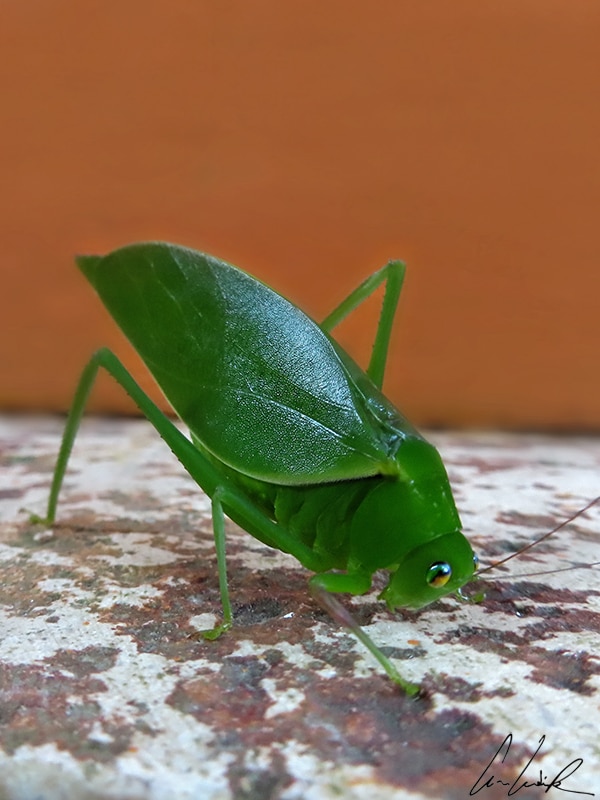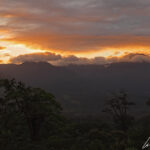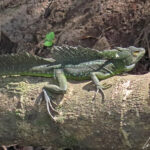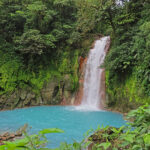Once almost unknown, the Tenorio Volcano National Park in northwest Costa Rica is home to a unique natural treasure: a sublime turquoise blue river and waterfall unlike any other in Central America or in the rest of the world ! On the Guanacaste mountain range, not far from the northern end of Lake Arenal, the Tenorio volcano rises to 6,286 feet. Its close neighbor, the Miravalles volcano, is slightly higher at 6,620 feet. The Parque Nacional Volcán Tenorio is one of the newest parks in Costa Rica. Since 1976, the area around the volcano has been protected, and it became a national park in 1995. More recently the park has been expanded to cover an area of 184 km2. It is located about 26 miles northeast of the town of Fortuna. The hiking trail « Misterios del Tenorio » allows you to discover most of the park’s wonders and possibly enjoy a spicy encounter with the local inhabitants. Beware the « Cruce de fauna » for the valleys and mountains of the park are full of biodiversity !

The Rio Celeste is a gorgeous natural river
Hiking the Rio Celeste in the Tenorio Volcano National Park
The « Misterios del Tenorio » trail extends along the Rio Celeste, named from its usually turquoise blue waters (« Celeste » means sky-blue in Spanish). The 3.7 miles round-trip hike begins in the dense forest and on the often-muddy trails of the slopes of the Tenorio volcano. The trail is not particularly strenuous and requires only about 3 hours on a good day. For those who left their raincoats and rain boots on their last vacation in Brittany, boots can always be rented at the park entrance ! You will quickly see that the charm of Rio Celeste is its turquoise color. But, even after a gorgeous sunset, heavy rains can fall during the night, and instead of this beautiful color you may see only muddy waters.

The blue lagoon or « Laguna Azul »
From the path, we take the stairs to the waterfall–the highlight of the show according to our guide – and continue our ascent to the mirador or lookout point. From there we enjoy a lovely view of the master of the place, the Tenorio volcano. A few hundred feet further lies the sublime Laguna Azul (blue lagoon) ! One is easily bewitched by the enchantment of the place, so much so that we almost forget to notice the rich fauna populating the tropical forest. Do you see it ? There, on the branch at the edge of the water. Uh, no, I don’t see anything except the branch reflected in the turquoise water… But look closer, lizards are camouflaged in the trees, each basking on its branch at the edge of the Rio Celeste… But isn’t that one the famous green basilisk ? Ouch, ouch, what will happen when we cross its line of sight ?
« Of the many fearsome beasts and monsters that roam our land, there is none more curious or more deadly than the basilisk, also known as the King of Serpents. This snake, which may reach a gigantic size, and live many hundreds of years, is born from a chicken’s egg, hatched beneath a toad. Its methods of killing are most wondrous, for aside from its deadly and venomous fangs, the basilisk has a murderous stare, and all who are fixed with the beam of its eye shall suffer instant death ».
(From a Hogwarts book quoting the Basilisk in the Chamber of Secrets)
Although we search the dense rainforest with great care, no « Fumseck » is found on the horizon to come to our rescue… But where is Albus Dumbledore’s damned Phoenix hiding ? Attracted by drumming on a lone tree on the other side of the Rio Celeste, we get our hopes up. But it is only a Pileated Woodpecker (Dryocopus lineatus) with a magnificent red crest… A little further on, we see a bird with entirely black plumage and a black grooved beak: the Groove-billed Ani (Crotophaga sulcirostris.) It is certainly not the « Fumseck », which has red and gold plumage! There is some movement in the foliage on our right; we see a bit of orange and black plumage. Missed again !… It is just a Baltimore Oriole (Icterus galbula).

A Pileated Woodpecker

A male Baltimore Oriole
Granted, the Jesus Christ lizard doesn’t turn water into wine or actually walk on water–it runs. Yet this aquatic run seems almost miraculous at first glance. Scientists (notably Tonia Hsieh and George Lauder, biologists at Harvard University), who have carefully studied each stride of the reptile’s hind legs, have a rational explanation: a perfect balance between mass, speed, and strength! When the green basilisk runs on water, biologists have observed that the movement of its webbed toes is divided into three sequences. First, the lizard’s paw lands flat on the water with a large contact surface of .8 sq. in (5cm2). Then the paw sinks into the water, creating an air cavity. Simultaneously, the paw moves like an oar propelling the lizard forward as a crawl swimmer would with his arms. The retraction of the paw before the air cavity closes is the key to running on water. The green basilisk can retract its paw in less than 25 milliseconds. Thus, the time interval between two strides is only about 70 milliseconds. To oversimplify, we could say that the basilisk’s two webbed back legs allow it to create air cushions which it uses to walk on water… The miracle of the Jesus Christ lizard’s aquatic ballet is therefore not biblical. As proof, if this sprinting lizard stops running, it sinks like a stone !

An adult male basilisk
I can see you coming with the question… Could man run on water with a simple pair of fins and thus present himself as the Messiah ? Some researchers (probably a bit idle, let’s admit it) have done some calculations… If your feet are each five feet square (the size of a small surfboard) and you can attain Usain Bolt’s top speed of 27mph over 328 feet, then you have a chance… If not, try swimming !
The birthplace of the Rio Celeste: the Teñidero
We finally move on from contemplating the Laguna Azul and continue on the « Misterios del Tenorio » trail. A section of the river passes over hot springs and gas bubbles appear here and there as the only visible manifestations of the activity of the Tenorio volcano. This hike is also an opportunity to immerse yourself in the exuberant tropical vegetation. The trees rise straight to the sky, colonized by bromeliads and other epiphytic plants. Amidst the moss and lichens stand giant tree ferns. It is said locally that this forest contains 600 shades of green. Fortunately, a few colorful spots brighten up this green Eden: here, a Monnina flower with colors oscillating between blue and purple and grouped in clusters or a Centropogon granulosus in flaming red. A little further on, a plant with an erect bearing and thick leaves measuring more than three feet in height catches our eye, probably because of its beautiful bright red oval berries, quite similar to those of its cousin the coffee tree. It is a Notopleura uliginosa. One last little wooden bridge to cross, and we are where it all begins: the birthplace of the Rio Celeste, also called the Teñidero (« the dyers ») or the place where the two rivers meet. It’s fascinating, and we can’t help but stare at the two clear rivers joining into a brilliant burst of vivid blue water.

A little wooden bridge
How can we not believe in the magic of Mother Nature when we see the Buenavista River and the Quebrada Agria, two rivers with pristine clear water, unite to create a turquoise-colored river: the Rio Celeste. Or how not to believe in the legend the Malekus Indians tell in which the Tócu maráma, their supreme gods, finished painting the sky and the stars and then dipped their brushes into the river, which then become turquoise blue… But as the French writer André Gide would say:
« Stop believing, educate yourself ».
(André Gide – Les Nouvelles Nourritures)
So let’s get to the heart of the matter and answer right away the question that all travelers who have had the chance to see the phenomenon up close ask themselves: where does the blue color of the Rio Celeste come from? In 2013, a small group of researchers from the University of Costa Rica decided to discover the secret of this celestial blue. After different samples were taken from the three rivers (Rio Celeste, Quebrada Agia, and Río Buena Vista), a first enigma appeared: samples of the turquoise blue water of the Rio Celeste taken in the field became transparent in the laboratory… Faced with this mystery of the blue river, the scientists returned to the field to study other factors.

The Teñidero or the birthplace of the Rio Celeste
The deep turquoise hue is due to a phenomenon known as Mie scattering. When the Quebrada Agria with its acidic pH meets the Rio Buenavista with its aluminosilicate particles, the resulting combination creates the turquoise water. How does it work ? The change in pH (acidity) at the meeting point of the two rivers increases the size of the aluminosilicate particles from 184 nanometers to 570 nanometers. A fraction of these mineral particles appears as white sediment on the river bottom. However, most of the particles remain suspended in the Rio Celeste water to scatter light. The suspended mineral particles distribute sunlight in the same way that raindrops form a rainbow. In the rainbow, the drops of water act as prisms breaking down the white light into different colors. In the Rio Celeste, the specific size of the aluminosilicate particles means that only the bluish tones of the white light are scattered. This optical phenomenon is called Mie scattering (Lorenz-Mie solution).

A Swainson’s Toucan, also known as the Chestnut-Mandibled Toucan
Magical or scientific, everyone will choose his own interpretation of the Teñidero. For my part, my heart hesitates between the two… It’s time to turn around and retrace our steps. Let us be a little more attentive to the fauna along the way. Of course, we are not in a zoo. What you can see varies by time of day, season, and weather: a colorful frog hides in the dead leaves; a male Brown anole (Anolis sagrei), also known as the Cuban brown anole, quietly sits on a branch and unfolds its gular; a Swainson’s Toucan (also known as the Chestnut-Mandibled Toucan) is perched high in the canopy looking for fruit, and a nephila clavipes spider weaves its indestructible web… Did you know that nephiles weave the world’s largest webs ! The female nephila clavipe measures about 3 inches across, not including legs. She has long legs, bright colors, and a stretched abdomen that looks a bit like a skull… This spider weaves a web whose silk threads have golden reflections and stick firmly. Her work often exceeds three feet in diameter ! The trapped insects have no chance: the nephila bites its prey, injects a venom that will predigest the victim and then rolls it up in the silk of the web.
« Spider’s web
Heavy with dew
In the white morning !Delicate artwork
Which shudders and folds,
House of thread,
Stairs of silk !Grey spider,
Silver spider,
Your elegant ladder
Is shaking in the wind ».
(Madeleine Ley – Petites voix)
If you accidentally run into a spider web, you will notice that the silk threads have excellent ductility (stretch without breaking). Long before Spiderman came along, spiders and their elaborate webs were already fascinating scientists. The textile industry and biotechnology are very interested in the properties of spider silk thread, which is among the strongest on Earth. Spider silk is a natural protein fiber, a polymeric material consisting of long, filamentous proteins (fibroins) composed mainly of amino acids (glycine and alanine). The protein fiber’s strength, flexibility, and elasticity makes it a better material than the best synthetic fibers and more resistant to breakage than steel (5 times stronger) or Kevlar (3 times stronger). In 2018, the U.S. Army tested the ballistic performance of Dragon Silk fiber made from spider silk threads produced by genetically modified silkworms. This fiber is so light and strong that it is an ideal choice for making body armor.

A nephila clavipes spider
The Rio Celeste waterfall: a sacred place of the Maleku people
The French magazine Paris Match has apparently elected the Rio Celeste waterfall as the most beautiful in the world ! It is indeed beautiful! Of tectonic origin, the Catarata del Rio Celeste plunges from a height of 98 feet into a circular basin 55 feet deep and bordered by luxuriant vegetation. The Maleku people believe that the waterfall used to give birth to members of the community until a Scarlet Macaw arrived and spread its wings to stop the births. Unfortunately for the Maleku, few visitors to the Tenorio Volcano Park today are told of the spiritual significance of this place.

The Catarata del Rio Celeste or Rio Celest waterfall
The Rio Celeste is a sacred place for the Maleku or Guatusos indigenous community which today numbers no more than 500 or 600 (1,200 if we count mestizos). One of the oldest groups of people in the country, these men and women are very respectful of nature and still practice their ancestral rituals. They have succeeded, better than other Amerindian groups, in preserving their language and traditions. Although they have adapted to the modern world, they maintain a culinary memory (cooking meat over a wood fire; sacred drink, the “blood of the cocoa”) and the Ihaïca language within the family circle. A radio station (Radio Sistema Cultural Maleku) broadcasts daily programs in Maleku. If, like them, you are respectful of nature, here are some key words to remember:
- water = tii,
- earth = laká,
- stone = oktara,
- tree = koora.
« Nature offers both nourishment and healing for the body and wonder for the soul, heart and mind ».
(Pierre Rabhi, le paysan philosophe – French writer, farmer, and environmentalist of Algerian origin)
Living mainly from agriculture (cocoa and palm), fishing, and hunting (turtle, jaguar, and iguana), the botanical science of the Malekus allows them to heal themselves and to make handicrafts. Do not hesitate to acquaint yourself, during walks in the forest, with the medicinal properties of plants, barks, and roots that they know better than anyone… Here, taste the juice coming from this unknown leaf stem… Hum, the taste is bitter and provokes a quick numbness of the tongue and the lip: it is the remedy to relieve dental pain! Knowledge of the properties of plants also transforms the Malekus into fashion designers… Do you dream of a garment that you can’t find in any store? Then opt for a unique style of clothing made from tana, a material made from tree bark soaked in water and pounded on wooden blocks. After being dried and bleached in the sun, it can be sewn like leather. It is soft and reminiscent of suede.

The beautiful Rio Celest waterfall plunges 98 feet into a pool
When animals play hide and seek in the Tenorio Volcano Park: the art of camouflage
When you wander through the Tenorio volcano park, you will notice that some animals seem invisible to our eyes, even though they are not hidden. You could say that they have a skill for blending into the surroundings thanks to their camouflage techniques. By blending into their environment, animals can go unnoticed by their predators… or their prey ! Camouflage is a matter of survival in the wild. And when it comes to survival, Mother nature shows impressive ingenuity…

A small Green anole
The Green anole, the Art of camouflage: an example of homochromy
Homochromy is probably the best-known form of camouflage and the most widespread in the animal world. It is the ability of some animals to change their color according to their environment. An example is the small Green anole (still called American chameleon), immobile in the foliage of the tropical forest. It can be approached without any difficulty as it must think itself invisible ! We can quickly draw its portrait. The green coloring allows it to blend into the leafy vegetation. In contrast, the brown coloring allows it to not be seen in a dark environment such as the trunk of the trees. But this change of color can also be induced by other factors such as temperature or emotions:
- When he wants to warm up, the anole turns dark brown, which allows him to capture more sunlight.
- Males are very territorial and do not hesitate to fight other males to defend their territory. During a fight between two anoles, the winner will turn a bright green color while the loser will turn dull brown.

A leafhopper
The incredible camouflage ability of the leafhopper: an example of homotypy
An animal that uses homotypy adopts the colors of its environment and takes on its shape as well! Most animals that use this method of protection are insects like the leafhopper. It isn’t easy to see that the leafhopper is there, in front of us, and yet, the leafhopper is there, serene and motionless. The resemblance is precise because it even imitates the complex pattern of veins on the leaf’s surface. A queen of camouflage, it must be isolated from its natural environment for its insect-like forms to appear. The leafhopper has an elongated body, large antennae, and very long back legs that allow it to make exceptional jumps. Each leafhopper is unique in appearance: no two individuals are alike! The camouflage of the leafhopper is taken to a very high level: the shape and colors of its body reflect its environment, even copying the individual characteristics of the plants it imitates. Thus, leafhoppers can become almost perfect replicas of chewed, torn, rotten, dried out, partially decomposed, or fungus-covered leaves. Some even have fake holes in their wings.

A stick insect
Stick insects: the professionals of camouflage in a natural environment
Numbering several thousand species, stick insects also known as phasmids can imitate a wide variety of plant parts, such as branches, leaves, and bark. The name « phasma » is not insignificant: in Greek, phásma (ϕάὓμα) means « vision, specter, ghost ». These insects are masters in the art of camouflage, and they live up to their name. « Stick insect », « rod insect », and « Leaf insect », respectively, take on the appearance of a twig, a thorny stem, or a leaf. They can even imitate the natural movements of their environment: for example, a plant rustling in the wind… by trembling their legs ! This particular insect is a curiosity of nature. Faced with a predator, the stick insect resorts to thanatosis. Like a Hollywood actor, it simulates its death by letting itself fall from its leaf or branch. It can also free itself from the predator by amputating an entire appendage. During the next molt, it will be able to gradually recover the member. However, this faculty would seem to decrease with age. Some stick insects have the particularity of secreting unpleasant substances to put a bad taste in the mouth of a hungry predator. In contrast, others can direct a chemical spray, a bit like tear gas, at the attacker. Another fascinating fact about these masters of illusion: stick insects live like Amazons ! They can reproduce almost entirely without males, using a process known as parthenogenesis. Unmated females produce eggs that, when mature, become female phasmids. When a male manages to mate with a female, there is only a 50/50 chance that the offspring of this union will be male.
Find more on Costa Rica
- Explore the cloud tropical forests of Costa Rica
- Costa Rica: A Vast Reservoir of Biodiversity
- Arenal Volcano National Park, a natural wonder
- Fauna and flora of the Arenal Volcano National Park
- The Caño Negro Refuge: Pointed teeth and Feathers along the Water
- The head in the clouds in the Reserve of Monteverde
- Exploring the Costa Rican Pacific coast: the Carara National Park
- Exploring the Costa Rican Pacific coast: the Manuel Antonio Park



























